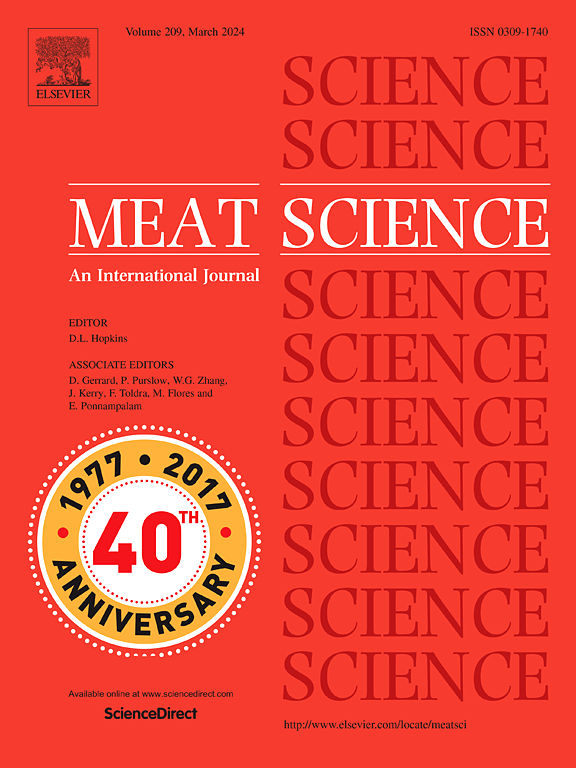Mitochondrial proteome basis for the biological variations in beef color stability of longissimus lumborum muscle differing in ultimate pH and packaging methods
IF 6.1
1区 农林科学
Q1 Agricultural and Biological Sciences
引用次数: 0
Abstract
This study investigated the influence of ultimate pH (pHu) and packaging methods on color, color stability, and the proteomic profile of the mitochondrial fraction of longissimus lumborum muscle from Nellore bulls. Bulls were categorized based on pHu levels as intermediate (5.8 < pHu < 6.2) or normal (pHu < 5.8). Following14-d aging, two packaging methods were evaluated: vacuum packaging and high oxygen-modified atmosphere packaging (HiOx-MAP). The findings revealed significant variations in color parameters and color stability between pHu categories and packaging methods. Proteomic analysis identified a total of 972 proteins, of which 225 were mitochondrial. Both mitochondrial and non-mitochondrial proteins resulted in significant differences in pathways related to energy metabolism, muscle contractility, and antioxidant defenses. Specifically, beef with intermediate pHu packaged in vacuum showed an upregulation of mitochondrial proteins associated with the MICOS complex (Mitochondrial contact site and cristae organizing system; APOOL, CHCH3, and MICOS13) and VDAC2 (Voltage-dependent anion-selective channel protein 2), indicating enhanced mitochondrial integrity compared to beef with normal pHu in vacuum packaging. Vacuum packaging effectively preserved color stability and supported proteolytic processes during aging, while HiOx-MAP initially produced a desirable cherry-red color but resulted in increased discoloration and oxidative stress over time, particularly in beef with normal pHu. These findings highlight the critical interplay between ultimate pH and packaging methods in optimizing beef quality during storage and aging.
最终pH值和包装方法不同的腰最长肌牛肉颜色稳定性生物学变化的线粒体蛋白质组学基础
本研究研究了极限pH (pHu)和包装方法对Nellore公牛腰最长肌线粒体部分颜色、颜色稳定性和蛋白质组学特征的影响。公牛根据pHu水平被分类为中等水平(5.8 <;福和& lt;6.2)或正常(pHu <;5.8)。经过14 d的老化后,评估了真空包装和高氧修饰气氛包装(HiOx-MAP)两种包装方法。研究结果揭示了pHu类别和包装方法之间颜色参数和颜色稳定性的显着变化。蛋白质组学分析共鉴定出972种蛋白质,其中225种是线粒体蛋白质。线粒体和非线粒体蛋白在能量代谢、肌肉收缩性和抗氧化防御相关的途径上都有显著差异。具体而言,真空包装的中间pHu牛肉显示与MICOS复合物相关的线粒体蛋白上调(线粒体接触位点和嵴组织系统;APOOL, CHCH3和MICOS13)和VDAC2(电压依赖性阴离子选择通道蛋白2),表明与真空包装中正常pHu的牛肉相比,线粒体完整性增强。真空包装有效地保持了颜色稳定性,并在老化过程中支持蛋白质水解过程,而HiOx-MAP最初产生了理想的樱桃红色,但随着时间的推移,会导致变色和氧化应激增加,特别是在pHu正常的牛肉中。这些发现强调了最终pH值和包装方法之间的关键相互作用,以优化牛肉在储存和老化期间的品质。
本文章由计算机程序翻译,如有差异,请以英文原文为准。
求助全文
约1分钟内获得全文
求助全文
来源期刊

Meat Science
工程技术-食品科技
CiteScore
12.60
自引率
9.90%
发文量
282
审稿时长
60 days
期刊介绍:
The aim of Meat Science is to serve as a suitable platform for the dissemination of interdisciplinary and international knowledge on all factors influencing the properties of meat. While the journal primarily focuses on the flesh of mammals, contributions related to poultry will be considered if they enhance the overall understanding of the relationship between muscle nature and meat quality post mortem. Additionally, papers on large birds (e.g., emus, ostriches) as well as wild-captured mammals and crocodiles will be welcomed.
 求助内容:
求助内容: 应助结果提醒方式:
应助结果提醒方式:


